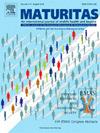Group-based pelvic floor telerehabilitation for urinary incontinence in older women: A six-month follow-up pilot study
IF 3.6
2区 医学
Q2 GERIATRICS & GERONTOLOGY
引用次数: 0
Abstract
Background
Urinary incontinence is prevalent among older women. This pilot study evaluated the effects of an online group-based pelvic floor muscle training program in older women with urinary incontinence at a six-month follow-up.
Methods
Women aged 65 and over, with stress or mixed urinary incontinence, were recruited. Eligibility was established through in-person evaluations, during which pelvic floor physiotherapists taught and verified correct pelvic floor muscles contraction using digital palpation. The 12-week online pelvic floor muscle training program comprised weekly one-hour training sessions, followed by an unsupervised maintenance exercise regimen. Data were collected before the program (PRE), immediately after (POST), during an interim phone call three months after the end of the program (3MO) and at a follow-up six months after the end of the program (6MO). Participants reported symptoms of urinary incontinence using a 7-day bladder diary and standardized questionnaires at PRE, POST and 6MO. Adherence to maintenance exercises was recorded at 3MO and 6MO. At 6MO, participants provided feedback on their perceived improvement and overall satisfaction.
Results
Women experienced a median leakage reduction of 73 % (range 38–88 %) from PRE to 6MO. Improvements were maintained from POST to 6MO for leakage episodes, symptoms of urinary incontinence, quality of life, and urinary incontinence self-efficacy. Adherence to maintenance exercises was substantial at 3MO and 6MO. Participants expressed high satisfaction with symptom improvement and the program overall at 6MO.
Conclusions
A 12-week online group-based pelvic floor muscle training including an in-person pelvic floor muscle evaluation and an unsupervised maintenance exercise regimen demonstrated sustained clinical benefits. Further validation through a randomized controlled trial is needed to confirm these findings.
基于组的盆底远程康复治疗老年妇女尿失禁:一项为期六个月的随访试点研究
背景:尿失禁在老年妇女中很普遍。这项初步研究评估了在线分组盆底肌肉训练计划对老年妇女尿失禁6个月随访的效果。方法招募年龄在65岁及以上、有压力或混合性尿失禁的女性。通过亲自评估来建立资格,在此期间,盆底物理治疗师使用指诊教导和验证正确的盆底肌肉收缩。这项为期12周的在线盆底肌肉训练计划包括每周一小时的训练课程,随后是一项无监督的保养性锻炼方案。数据收集于项目开始前(PRE)、项目结束后(POST)、项目结束后三个月(3MO)的临时电话中以及项目结束后六个月(6MO)的随访中。参与者使用7天膀胱日记和PRE、POST和6MO标准化问卷报告尿失禁症状。在3MO和6MO时记录维持运动的坚持情况。在6MO时,参与者提供了关于他们感知到的改善和总体满意度的反馈。结果从PRE到6MO,女性的中位渗漏减少了73%(范围38 - 88%)。从术后到术后6个月,尿漏发作、尿失禁症状、生活质量和尿失禁自我效能的改善一直保持。在3MO和6MO时,坚持进行维持性锻炼是非常重要的。在6MO时,参与者对症状改善和整体方案表示高度满意。结论:一项为期12周的在线小组盆底肌训练,包括盆底肌评估和无监督的维持运动方案,显示出持续的临床益处。需要通过随机对照试验进一步验证这些发现。
本文章由计算机程序翻译,如有差异,请以英文原文为准。
求助全文
约1分钟内获得全文
求助全文
来源期刊

Maturitas
医学-妇产科学
CiteScore
9.10
自引率
2.00%
发文量
142
审稿时长
40 days
期刊介绍:
Maturitas is an international multidisciplinary peer reviewed scientific journal of midlife health and beyond publishing original research, reviews, consensus statements and guidelines, and mini-reviews. The journal provides a forum for all aspects of postreproductive health in both genders ranging from basic science to health and social care.
Topic areas include:• Aging• Alternative and Complementary medicines• Arthritis and Bone Health• Cancer• Cardiovascular Health• Cognitive and Physical Functioning• Epidemiology, health and social care• Gynecology/ Reproductive Endocrinology• Nutrition/ Obesity Diabetes/ Metabolic Syndrome• Menopause, Ovarian Aging• Mental Health• Pharmacology• Sexuality• Quality of Life
 求助内容:
求助内容: 应助结果提醒方式:
应助结果提醒方式:


